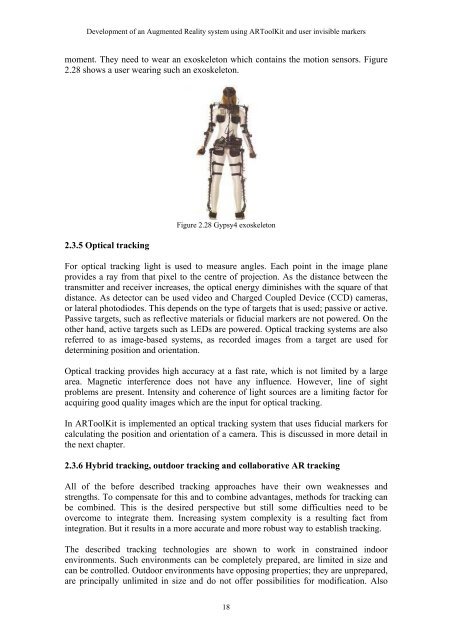Development of an Augmented Reality system using ARToolKit
Development of an Augmented Reality system using ARToolKit
Development of an Augmented Reality system using ARToolKit
You also want an ePaper? Increase the reach of your titles
YUMPU automatically turns print PDFs into web optimized ePapers that Google loves.
<strong>Development</strong> <strong>of</strong> <strong>an</strong> <strong>Augmented</strong> <strong>Reality</strong> <strong>system</strong> <strong>using</strong> <strong>ARToolKit</strong> <strong>an</strong>d user invisible markers<br />
moment. They need to wear <strong>an</strong> exoskeleton which contains the motion sensors. Figure<br />
2.28 shows a user wearing such <strong>an</strong> exoskeleton.<br />
2.3.5 Optical tracking<br />
Figure 2.28 Gypsy4 exoskeleton<br />
For optical tracking light is used to measure <strong>an</strong>gles. Each point in the image pl<strong>an</strong>e<br />
provides a ray from that pixel to the centre <strong>of</strong> projection. As the dist<strong>an</strong>ce between the<br />
tr<strong>an</strong>smitter <strong>an</strong>d receiver increases, the optical energy diminishes with the square <strong>of</strong> that<br />
dist<strong>an</strong>ce. As detector c<strong>an</strong> be used video <strong>an</strong>d Charged Coupled Device (CCD) cameras,<br />
or lateral photodiodes. This depends on the type <strong>of</strong> targets that is used; passive or active.<br />
Passive targets, such as reflective materials or fiducial markers are not powered. On the<br />
other h<strong>an</strong>d, active targets such as LEDs are powered. Optical tracking <strong>system</strong>s are also<br />
referred to as image-based <strong>system</strong>s, as recorded images from a target are used for<br />
determining position <strong>an</strong>d orientation.<br />
Optical tracking provides high accuracy at a fast rate, which is not limited by a large<br />
area. Magnetic interference does not have <strong>an</strong>y influence. However, line <strong>of</strong> sight<br />
problems are present. Intensity <strong>an</strong>d coherence <strong>of</strong> light sources are a limiting factor for<br />
acquiring good quality images which are the input for optical tracking.<br />
In <strong>ARToolKit</strong> is implemented <strong>an</strong> optical tracking <strong>system</strong> that uses fiducial markers for<br />
calculating the position <strong>an</strong>d orientation <strong>of</strong> a camera. This is discussed in more detail in<br />
the next chapter.<br />
2.3.6 Hybrid tracking, outdoor tracking <strong>an</strong>d collaborative AR tracking<br />
All <strong>of</strong> the before described tracking approaches have their own weaknesses <strong>an</strong>d<br />
strengths. To compensate for this <strong>an</strong>d to combine adv<strong>an</strong>tages, methods for tracking c<strong>an</strong><br />
be combined. This is the desired perspective but still some difficulties need to be<br />
overcome to integrate them. Increasing <strong>system</strong> complexity is a resulting fact from<br />
integration. But it results in a more accurate <strong>an</strong>d more robust way to establish tracking.<br />
The described tracking technologies are shown to work in constrained indoor<br />
environments. Such environments c<strong>an</strong> be completely prepared, are limited in size <strong>an</strong>d<br />
c<strong>an</strong> be controlled. Outdoor environments have opposing properties; they are unprepared,<br />
are principally unlimited in size <strong>an</strong>d do not <strong>of</strong>fer possibilities for modification. Also<br />
18
















